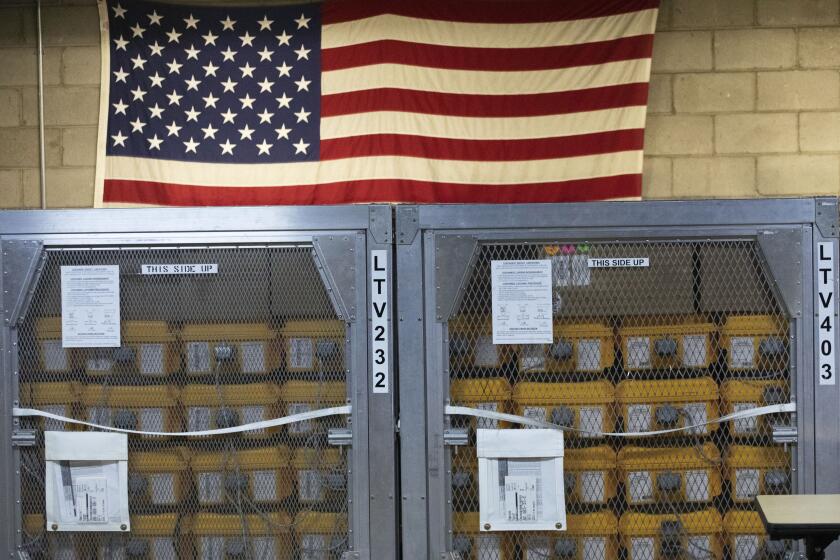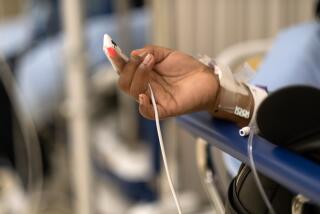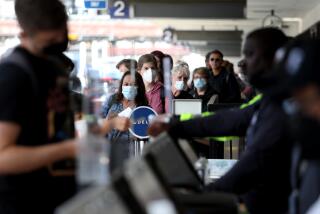Ventilators for coronavirus patients are in short supply. How scientists might pivot
- Share via
At hospitals facing a flood of people infected with the new coronavirus and a shortage of equipment to treat them, an unspoken question looms over every medical interaction: Will this COVID-19 patient need a ventilator to survive?
Somewhere between 10% and 25% of patients sick with COVID-19 eventually require assistance to breathe. Roughly 5% of patients will develop acute respiratory distress syndrome, at which point only a mechanical ventilator can drive oxygen into their lungs and push fluid out.
Recognizing the difference between those whose survival depends on access to a ventilator and those who can recover with less aggressive breathing assistance has become a vital skill for doctors.
The United States has roughly 173,000 ventilators scattered across the country, according to the Center for Health Security at Johns Hopkins University. It may sound like a lot, but there could be 31 times as many patients who need one, experts from Harvard Medical School predict.
In places such as New York and Detroit, where the number of very ill patients is projected to peak in the next two weeks, ventilator shortages have already been reported. Unless thousands more machines arrive, doctors there will face painful decisions about which patients to save and which to let die.
So while hospitals and health officials work to increase the supply, scientists are testing ways to reduce the demand by diverting COVID-19 patients from the path that would typically end with a ventilator.
Their work, if successful, would not only free up machines for the sickest of patients. Patients able to avert the need for mechanical ventilation would avoid the risks that come with being anesthetized and intubated, including lung damage and death.
“All around the country, we’re highly concerned about ventilator shortages, so we’re looking for every possible way to provide respiratory support to patients,” said Dr. Mark Hepokoski, a UC San Diego critical care specialist.
Recognizing which patients will recover with less aggressive treatments is not easy with a wholly new disease, but it’s essential, he added.
Acute respiratory distress syndrome, or ARDS, is the endgame for the unluckiest COVID-19 patients. By that point, the virus has begun to destroy the tiny compartments in the lungs where blood normally collects oxygen. Roaring inflammation, a response to infection, further deteriorates the lung’s ability to draw in air. Without help, these patients could drown.
More than a dozen medications that were developed to treat other diseases are now being tested on COVID-19 patients. Ideally, several of them would allow patients with mild to moderate symptoms recover before their illnesses reach the severe or critical stage.
But researchers are not stopping there.
They are also using artificial intelligence to identify patients who are most likely to develop ARDS and need the gold standard treatment to survive. They’re devising ways to provide breathing assistance with techniques short of mechanical ventilation. If the ventilator shortage becomes desperate, as it has already in some New York City hospitals, doctors will likely try some of these alternatives to rescue dying patients.
Who lives and who dies? It’s an inevitable choice doctors face if coronavirus cases keep surging.
COVID-19 was bound to be a challenge because it’s a new disease. To make matters worse, its symptoms and progression vary substantially among patients. That means doctors have no reliable intuitions about a patient’s prognosis.
Patients who are older, male and have underlying conditions such as heart disease, diabetes or asthma tend to have worse outcomes. But there are exceptions to that pattern. As they assess incoming COVID-19 patients, doctors need better ways to predict the courses their charges will likely take.
A team of researchers in China and at New York University turned to machine learning to see whether useful clues could be found through a massive scouring of symptoms, blood test results and patient characteristics.
Aided by artificial intelligence techniques, the researchers performed an exhaustive scrub of data from 53 patients who were treated in a hospital in Wenzhou, China. Their work identified the three top signs of a patient likely to develop critical illness, as well as their order of importance.
The resulting list amounts to a step-by-step “decision tree” to help doctors triage patients early and set aside scarce ventilators for the right ones.
At the top of the list: a slightly elevated level of the liver enzyme alanine aminotransferase, or ALT. It is one of 20 measures of metabolic and organ function, blood oxygenation and inflammation that’s routinely tested in all hospitalized patients.
In those who would go on to develop ARDS, ALT levels were so slightly above normal that “it would not necessarily set off alarm bells,” said Dr. Megan Coffee of NYU, who has been working on the research while treating COVID-19 patients. But in winnowing out patients most likely to need a respirator, it offers a powerful first clue.
Once that liver enzyme reading has tripped the alarm, a patient’s report of overall achiness appears to hold important information. After that, there’s a high likelihood of trouble ahead if sign No. 3 is present — an elevated hemoglobin level that looks like the opposite of anemia.
A patient’s male gender, higher temperature and abnormal sodium levels were measures 4, 5 and 6 on the list of predictors.
Inhaled nitric oxide appeared to kill the coronavirus that caused severe acute respiratory syndrome, or SARS, and it might work on COVID-19 as well.
Other common signposts weren’t so valuable, the analysis found. Physicians will routinely look to measures like a patient’s age, lymphocyte count and white blood cell count to gauge how sick he or she may be. But those all fell near the bottom of the list of predictive measures.
Coffee said her work in the West African Ebola outbreak led her to expect a patient’s viral load would be revealing. But the team’s AI methods suggest that in COVID-19 patients, it’s not.
Likewise, whether a patient arrived at the hospital with breathing difficulties offered no help at all in identifying those who would get sickest. That symptom was just too common among patients across the board, Coffee said.
Coffee and her colleague Anasse Bari of NYU’s Courant Institute plan to refine their prediction tool by adding in the disease histories of more than 14,000 COVID-19 patients that have been admitted to New York City hospitals. Bari hopes a reliable decision tree will help guide healthcare workers in countries such as his native Morocco, where hospitals are expected to be overwhelmed in the pandemic.
Another approach is to find existing medical equipment that can function like a ventilator in certain circumstances.
A leading contender is the bilevel positive airway pressure device that is ordinarily used to help patients with breathing problems that have not progressed to the critical stage. BiPap machines could be used to wean some improving patients from the invasive mechanical ventilators, freeing them up for incoming patients, said Dr. Atul Malhotra, a lung specialist at UC San Diego. Already used widely in New York City, where COVID-19 patients are outstripping ventilators, BiPap machines deliver oxygen under pressure through a mask. Patients can readily pull them off to cough or because they are uncomfortable, so they pose extra infection risks to healthcare workers.
How can the new coronavirus affect people so differently — killing some while leaving others blissfully unaware that they have been infected at all?
There’s also the machines that pump anesthesia into patients during surgical procedures. With minor modification, they could provide mechanical ventilation for COVID-19 patients who have developed respiratory distress.
Indeed, the Food and Drug Administration and the American Society of Anesthesiologists have issued step-by-step instructions for converting the machines for use with COVID-19 patients.
Those machines have largely been freed up by the shutdown of elective surgeries. The ASA estimates that 70,000 anesthesia machines are available in hospitals and ambulatory care centers across the country.
Regular ventilators could also be modified so they can be shared by more than one patient.
“Such a strategy should only be considered as an absolute last resort,” according to guidance from federal health officials. In a “crisis-care, life-or-death situation,” neither the FDA nor the Centers for Disease Control and Prevention would bar the practice.
But patients sharing a single ventilator might infect each other with bacteria and viruses, and doctors would not be able to carefully calibrate the pressure at which oxygen is delivered. For some patients, lung damage could result from oxygen delivered under too much pressure; others who are forced to share could die from getting too little.
And if one patient on a shared ventilator should go into cardiac arrest, the ventilation of any other patients sharing the device would have to be stopped so the heart attack victim’s breathing tube could be removed and resuscitation efforts begun.
Regulators might bring new machines online as well. One of them is HemoLung, which functions like a dialysis machine for the lungs by removing carbon dioxide from blood. That could spare some patients with ARDS the need for mechanical ventilation, or at least delay that need.
HemoLung has been approved since 2013 in Europe, where it’s used for patients with emphysema and ARDS. It’s currently in clinical trials, not for COVID-19 patients but for patients with ARDS caused by other disorders, at 34 sites in the United States, and its inventor, University of Pittsburgh bioengineer William Federspiel, has asked the FDA to issue an “emergency use authorization” that would make it available to COVID-19 patients.
Each of the 34 U.S. clinical trial sites has two HemoLung consoles, and they could be used with an FDA waiver. If the device shows promise, he added, the company may attract enough capital to ramp up production before a vaccine can be developed.
There’s also a helmet that looks like an overturned fishbowl.
Sealed by a rubber collar and clamped to a patient’s shoulders by a pair of under-arm straps, helmet-based ventilation could delay — if not eliminate — the need for a standard ventilator. In a trial at the University of Chicago, 30% of patients who got their oxygen through the helmet were able to avoid intubation altogether.
The helmet-based ventilation has been widely used on COVID patients in Italy, France and Spain, said Dr. John P. Kress of the University of Chicago, a critical care specialist who has championed the use of helmets, which can be attached to standard “medical air” outlets behind virtually all hospital beds. “But the equipment just never took off here like it did in Europe,” he said.
Many large medical centers have a few helmets tucked away in their respiratory department’s store room, Kress added. If they perform well in the ongoing trials, they may see the light of day.









